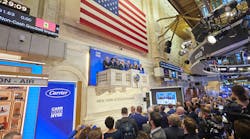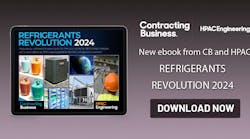Countries around the world are showing new signs of readiness to act on carbon emissions. That means new pressures to make buildings highly efficient in their use of electric power, particularly as a recent report from the U.S. Environmental Protection Agency1 shows that, between 1990 and 2013, indirect greenhouse-gas emissions from the electricity use of homes and businesses increased 28 percent. However, perceptions of ultramodern, high-efficiency commercial buildings may not align with the realities of a low-carbon built environment. The United States will need to work primarily with existing buildings, as opposed to new construction. Thus, the future of high-performance commercial buildings is linked integrally to retrofits, and a successful retrofit strategy for environmentally sustainable commercial buildings will require a fresh approach and new kinds of innovation.
Buildings by the Numbers
First, it is vital to understand the profile of commercial buildings in America is changing.
According to the U.S. Energy Information Administration’s Commercial Buildings Energy Consumption Survey, there were about 5 million commercial buildings in the United States in 2003. By 2012, that number had risen 14 percent to 5.6 million. Over the same period, total commercial-building square footage increased 21 percent, from just over 70 billion to 87 billion.
The median building today is 32 years old; about half of America’s commercial buildings were built before 1980. Only 2 percent of buildings are larger than 100,000 sq ft, while about half are 5,000 sq ft or smaller.
America’s building profile varies significantly by region. For example, the South has 46 percent of new buildings and 37 percent of the population. Almost half of all buildings built in the United States since 2000 are in the South. By contrast, the Northeast is home to the largest and oldest building. Whereas the median age of commercial buildings in the South is 29 years, in the Northeast, it is 46 years, with the buildings on average 4,000- to 5,000-sq-ft larger. Buildings in the Mid-Atlantic region average 22,300 sq ft.
The Rise of Retrofits
Citing McGraw Hill data, the U.S. Green Building Council observed that 61 percent of all construction projects today are retrofits; in many population centers, the percentage is much higher. The importance of retrofitting grew in the wake of the 2008 financial crisis and recession, which were hard on commercial properties and created uncertain loans and major losses for banks. The impact remains significant, as bank losses have weakened capital reserves and the ability to make new loans. Falling real-estate prices and tighter credit standards weakened the new-construction market.2,3
The rise of retrofits, however, has not translated directly into more sustainable buildings. Whereas “retrofit” means changing out elements or components of a building, and “green” retrofit means upgrading a building to a higher environmental-certification standard, achieving genuine sustainability requires something more.
Deep Energy Retrofits
Rocky Mountain Institute (RMI) has been working on what that something more might be: the deep energy retrofit. In 2010, RMI proposed a deep-energy-retrofit plan for the Byron G. Rogers Federal Building and U.S. Courthouse in Denver, a project it regards as “a powerful case study for dramatically improving performance of existing buildings.”
The plan was very aggressive, with a goal of reducing the building’s energy consumption by 70 percent. The U.S. General Services Administration (GSA), which owns the 620,000-sq-ft building, used $147 million from the American Recovery and Reinvestment Act to fund a large portion of the project, which, in total, cost about $160 million.
New ideas in space use, including flexible work spaces and shared meeting rooms, were deployed for the Byron G. Rogers Federal Building and U.S. Courthouse, which houses 11 government agencies. Central to the retrofit strategy was chilled-beam technology, whereby chilled water is fed through beams that act as radiators. Solar collectors were added to provide all of the building’s hot water.
The GSA reports the building now uses less than 45.1 kBtu per square foot per year (note the “whole building” metric) and achieves annual energy savings of about 55 percent.
In addition to chilled beams and solar collectors, the deep-energy-retrofit toolkit offers access to demand-response technology, thermal-energy storage, cogeneration (combined heat and power), and more. Integrated, these technologies can dramatically improve building performance in absolute terms and relative to peak load. By not only cutting total energy use, but shifting the time at which electrical power is demanded by the building, such technologies woven into a whole-building systems strategy can draw on the grid during low-demand periods and reduce load during peak or high-demand periods, cutting the need for the added high-cost, high-carbon peak power generation otherwise required.
Despite the many advantages of deep energy retrofits, owners have been reluctant. As Building Science Corp.’s Ken Neuhauser said4: “Deep energy retrofits are hard. They are not simple, quick, or cheap.” In most cases, that translates directly into a financing challenge because, to a bank with tight credit standards for buildings, hard, complex, slow, and expensive means risky.
Financing Deep Energy Retrofits
Financing deep energy retrofits requires innovative and collaborative thinking. For example, in 2013, Seattle Mayor Mike McGinn announced a pilot project between Seattle City Light and the Bullitt Foundation to make deep energy efficiency in new and existing commercial buildings economically feasible.
“Very few building owners now make the large, long-term investments needed to achieve ‘deep’ savings of 35 to 50 percent,” the announcement of the project5 notes. “Yet the rates of return on such investments would be attractive to utilities and other investors that have access to cheap, long-term capital. The new pilot program aims to overcome this obstacle.”
The two pillars of the program are (1) an “energy-efficiency meter to objectively measure real-time energy savings and (2) a 20-year contract between a utility and energy-efficiency investors,” the latter of which “allows an investor to profitably invest in energy-efficiency upgrades with longer payback times.” Investments can be made through traditional vehicles, such as bonds, though the best mechanisms for getting returns have yet to be determined.
In an article for the Seattle Daily Journal of Commerce,6 Thulasi Narayan explained the program.
“At the net-zero Bullitt Center, Seattle City Light and the building owners are pioneering a potentially game-changing power-purchase agreement termed MEETS, or metered energy-efficiency transaction structure,” Narayan wrote. “City Light pays the building owner for energy saved against a baseline, similar to the credits that homeowners receive when solar panels on their roof generate more energy than the house is using.
“Making this incentive structure a reality relies on sophisticated technology that identifies how multiple factors (such as occupancy, schedule, or weather) impact energy consumption and comparing that to how the building actually performs at the utility meter,” Narayan continued.
“By understanding the environmental factors that influence energy consumption, the utility knows it is paying for real energy savings, rather than incidental savings coming from fewer occupants being in the building or unseasonably mild weather,” Narayan concluded.
The article quotes Rob Harmon, president and chief executive officer of Energy Resource Management Corp., maker of the baseline metering system utilized for MEETS, who said the project is a way to “enable a true ‘pay-for-performance’ market, including long-term power-purchase agreements that will allow deep energy-efficiency retrofits to join wind and solar as at-scale solutions for our energy system.”
It is not hard to see how monetized energy savings could add to the book value of a building and create new incentives for transparency regarding energy consumption. Owners have not always warmed to the idea of reporting energy use and disclosing it at the time of sale. Transparency has been seen as more of a risk factor in determining building value, though cities such as Philadelphia and Boston have mandated the reporting of energy use for midsize and large buildings, and others are exploring the possibility of doing so. A building that creates an income flow to the owner or investor, however, is a different matter.
All of this said, valuation in a new era of high-performance buildings is a science yet in its infancy. Projects in the United States and Europe are exploring possibilities, some building brokers have built such calculations into their business models, and the underlying logic is clear enough. But establishing the value of an investment in a deep energy retrofit with sufficient specificity to influence the price of a building remains a work in progress.
More Than Timely Innovation
The Denver and Seattle projects illustrate how new alignments and opportunities for breakout levels of energy savings through retrofits—from those in technology and building-system integration to those among the public and private sectors, foundations, non-governmental organizations, and others—can develop. The Denver project highlights the advantages of holistic retrofit design, while the Seattle project identifies a value not assessed by the marketplace and creates an instrument permitting the marketplace to assess it.
Increasingly, the world is facing up to its carbon emissions and sustainability challenge and recognizing the significant opportunity within aging commercial buildings. But typical improvements in building energy performance are too modest and too slow to meet the goals now being deemed necessary. Building performance is stalled; there is less of the dramatic new construction many thought leaders envisioned and more of the “lite” retrofits that comparatively lack impact. Together, the Denver and Seattle projects represent a new standard for innovation that will need to be met if the world’s aspiration for high-performing and efficient buildings is to become reality and the retrofit opportunity is to be realized.
References
- EPA. (n.d.). Sources of greenhouse gas emissions. Retrieved from http://bit.ly/EPA_GHG
- Veiga, A. (2009, August 22). Commercial real estate: Inside the crisis. HuffPost Business. Retrieved from http://bit.ly/Veiga_HuffPost
- Viau, K., & Kim, Y. (2015, February 26). Commercial real estate in economic crisis: An interview with James O’Brien of Davis Polk & Wardwell. Business Law Journal. Retrieved from http://bit.ly/Viau_Kim
- Stefanakos, V.S. (2010, March 11). What is a deep energy retrofit? Experts at the NESEA Conference respond. Retrieved from http://bit.ly/Stefanakos_EnergyCircle
- OED. (2013, June 12). New pilot unlocks deep energy efficiency in buildings. Retrieved from http://bit.ly/OED_DeepEnergy
- Narayan, T. (2015, February 26). Energy tools that could change the game. Seattle Daily Journal of Commerce. Retrieved from http://bit.ly/Narayan_Energy
Lisa Tryson is director of corporate communications and public relations for Danfoss North America, manufacturer of controls and components for HVAC and allied industries. Previously, she headed global marketing communications for the company’s Refrigeration & Air Conditioning division in Denmark. She leads Danfoss’ EnVisioneering thought-leadership program.
Did you find this article useful? Send comments and suggestions to Executive Editor Scott Arnold at [email protected].










